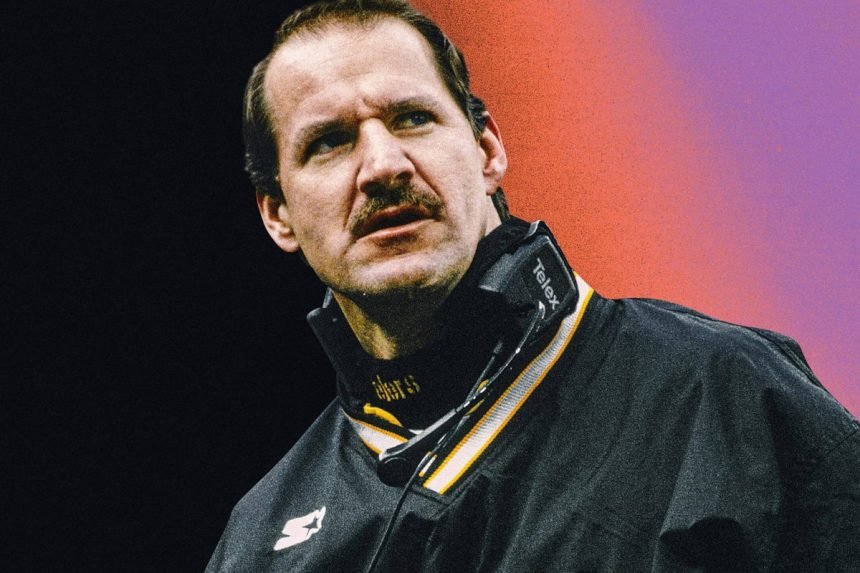Editor’s note: This story is part of Peak, The Athletic’s desk covering leadership, personal development and success through the lens of sports. Follow Peak here.
The Athletic has coverage of NFL Week 3: Latest news and live updates
Bill Cowher can recall with certainty when he first made the wonderful discovery that he possessed leadership qualities. He was 10 years old, playing in the Little Cougars Youth Football Organization in Crafton, Pennsylvania: We’re going out on the field and we’ve got to have each other’s backs.
It came naturally to him. As a kid, he never had a problem speaking up, and he was always the one on the playground who would select team captains and establish the rules.
When you think of the NFL coaches who personified leadership over the last 30 years, Cowher — he of the famous intensity and jutting jaw — easily comes to mind. He compiled a 149-90-1 record during his 15 seasons as the head coach of the Pittsburgh Steelers. His teams made the playoffs 10 times and won the Super Bowl in 2006. During his coaching career, he repeatedly referenced two books. Both were from Norman Vincent Peale: “The Power of Positive Thinking” and “Enthusiasm Makes the Difference.”
“I used to read them in the morning and then tried every day to have a positive impact on people,” Cowher said. “I truly believe enthusiasm does make a difference. If your mind is very powerful, why not fill it with positive thoughts?”
Cowher retired from coaching after the 2006 NFL season and joined CBS Sports, where he is now in his 19th year. But bring up the topic of leadership and he still gets excited and fiery.
“I’ve thought a lot about leadership,” Cowher said. “I think the definition of leadership is the ability to do these three things: to unite people, to guide the direction that you’re going and to inspire all toward a common goal. Leadership requires a lot of different traits. It requires a lot of different things to do. So here are three things that it requires.”
1. Have the courage to do things and have a vision to know what you want out of it
I asked Cowher for an example of this. He brought up Rod Woodson, a Hall of Fame defensive back with the Steelers. Cowher described a Steelers-Bills game on Nov. 14, 1994, when Woodson jumped a route and picked off Bills quarterback Jim Kelly for a touchdown. Woodson told Cowher that he could make decisions based on hearing audibles from quarterbacks, and Cowher gave his player the freedom to trust his instincts.
What Cowher made clear was that not everyone was a Hall of Fame player like Woodson, and leadership required knowing which players could do what.
“Rod used to catch punts above his head,” Cowher said. “That’s not how you’re supposed to catch a punt. He’d say, ‘But I don’t ever drop it.’ OK, you’re Rod Woodson. You do it that way. But the guy backing up Rod Woodson? You do it the way I’m telling you, which is you look the ball into your hands. So, you cater to who you have and allow them to be who they are.”
2. Great leadership requires great humility
At the start of each season, Cowher would tell his team they had to learn how to trust.
“We have to trust the system and trust the guy next to you,” he’d say. “But, more importantly, you have to trust yourself. By the end of the season, when you trust yourself, you’ll make the right choices. You’ll experience personal growth, and that personal growth will be collective growth.”
What Cowher learned was the value of seeing a team holistically and therefore drafting players that fit into a culture.
“It wasn’t about having the best 53 players,” he said. “It was about having 53 players who accepted the role they had, excelled at that role and felt like they were all one part of that wheel. No one felt any bigger than anyone else. This is why I always go back to humility. All good leaders need it.”
3. Leadership requires a willingness to listen, to learn and to adapt
Cowher said he learned about preparation and the value of perspective from his coaching mentor, Marty Schottenheimer. From watching Bill Parcells and Bill Belichick, he learned the ability to move on to the next game, never letting a team get too high or too low.
“In Pittsburgh, I tried to create a culture that really fostered collaboration and innovation, and the players took ownership over that,” he said. “There was collaboration with everything we did, connecting players and coaches and the front office. Everything we did in that building was collaboration and innovation.”
“Also,” he said, “don’t be afraid to think outside the box. Don’t be afraid to take some chances. I didn’t want people around me that would agree with everything I had to say. I wanted to be able to have a dialogue. I wanted you to make me think and provoke thought with me. If you could not provoke thought, then, to me, I didn’t want you on my staff.”
In 2005, the Steelers started 7-2 before losing three straight games to the Ravens, Colts and Broncos. Most NFL observers did not believe the Steelers would make the playoffs, but they won their last four games to get into the playoffs as the sixth seed.
As Cowher noted, plenty of publications highlighted that no sixth seed had ever advanced to the championship game, let alone the Super Bowl. Prior to Pittsburgh’s first playoff game, Cowher told his players about a figure from history who was told that his goal and objective were not possible because no one had done it before.
“My point very simply was: Don’t let history dictate your future,” Cowher said.
The Steelers went on to win road games in Cincinnati, Indianapolis and Denver before beating the Seahawks in the Super Bowl. They remain one of only two No. 6 seeds (along with the Packers in 2010) to win a Super Bowl.
Cowher last coached on December 31, 2006, almost 20 years ago. He has still found ways to demonstrate his leadership philosophy as a television broadcaster.
“I would take donuts out to the floor, to the cameraman, to the producers, to (broadcast associates), to the graphics people because it was making sure everyone felt like they were part of this team,” Cowher said. “I never wanted them to feel like they’re anything less than we are, so it’s kind of like making everyone feel like we’re one big family. You want people to feel like it’s great to be here, and this will be our best show yet. I like to think we haven’t had our best show yet, but our best show is going to be today.”
(Illustration: Dan Goldfarb / The Athletic; Focus on Sport / Getty Images)











